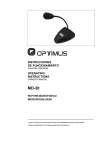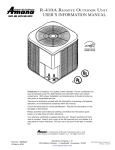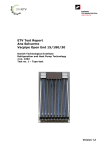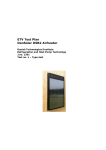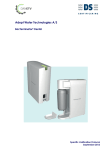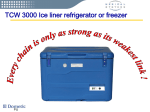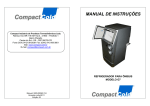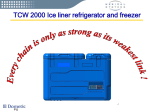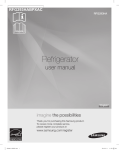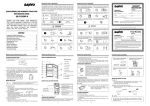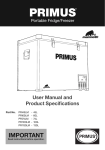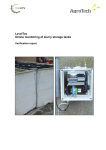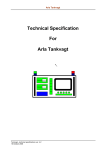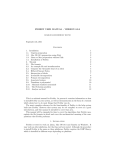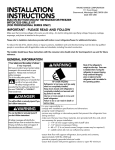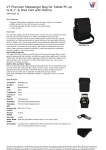Download Verification Report SolarChill B for domestic and “light” commercial
Transcript
Verification Report SolarChill B for domestic and “light” commercial use series DTI Refrigeration and Heat Pump Technology J.no. 1101 Test no. 1 – Type-test Version 1.1 1. Table of Contents 1. 2. Table of Contents ..................................................................................................................... 2 Introduction .............................................................................................................................. 3 2.1. Name of product ............................................................................................................... 3 2.2. Name and contact of vendor ............................................................................................. 3 2.3. Name of centre/verification responsible ........................................................................... 3 2.4. Verification and test organization..................................................................................... 3 2.5. Expert group ..................................................................................................................... 5 2.6. Verification process .......................................................................................................... 5 3. Description of the technology .................................................................................................. 5 4. Description of the product ....................................................................................................... 7 5. Application and performance parameter definitions................................................................ 8 5.1. Matrix/matrices ................................................................................................................. 8 5.2. Target(s)............................................................................................................................ 8 5.3. Effects ............................................................................................................................... 8 5.4. Performance parameters for verification .......................................................................... 9 5.5. Additional parameters....................................................................................................... 9 6. Existing data............................................................................................................................. 9 6.1. Summary of existing data ................................................................................................. 9 6.2. Quality of existing data................................................................................................... 10 6.3. Accepted existing data .................................................................................................... 10 7. Test plan requirements ........................................................................................................... 11 7.1. Test design ...................................................................................................................... 11 7.2. Reference analysis .......................................................................................................... 11 7.3. Data management ........................................................................................................... 11 7.4. Quality assurance ............................................................................................................ 11 7.5. Test report ....................................................................................................................... 12 8. Evaluation .............................................................................................................................. 13 8.1. Performance parameter summary ................................................................................... 13 8.1.1. Control data ............................................................................................................. 14 8.1.2. Audits No audits were performed. ......................................................................... 14 8.1.3. Deviations................................................................................................................ 14 8.1.4. User manual............................................................................................................. 15 8.1.5. Occupational health and environment ..................................................................... 15 9. Liability exclusion ................................................................................................................. 16 10. Quality assurance ............................................................................................................... 16 2. Introduction Environmental technology verification (ETV) is an independent (third party) assessment of the performance of a technology or a product for a specified application, under defined conditions and quality assurance. DANETV is a Danish center for verification of environmental technology. The verification is conducted under the verification protocol for the specific technology tested in accordance with the test plan. 2.1. Name of product The product is the SolarChill B for domestic and “light” commercial use series 2.2. Name and contact of vendor SolarChill Project Coordinator, Mr. János Maté Contact: 5106 Walden St., Vancouver, BC., Canada V5W 2V7 Phone: +1-604-327-0943, E-mail: [email protected] 2.3. Name of centre/verification responsible Danish Technological Institute ,Verification Center, Refrigeration and Heat Pump Technology, building 2, Gregersensvej, DK-2630, Taastrup, Denmark. Verification responsible: Emil Jacobsen (EMJA), e-mail: [email protected], phone: +45 7220 2323 Internal reviewer: Bjarke Paaske, e-mail: [email protected], Phone: +45 7220 2037 2.4. Verification and test organization The verification was conducted by Danish Technological Institute. The test organization is shown in Figure 1. The verification was planned and conducted to satisfy the requirements of the ETV scheme currently being established by the European Union (EU ETV). Verification and tests was performed by Danish Technological Institute under DANETV under contract with Danfoss A/S. The day to day operations of the verification and tests was coordinated and supervised by TI personnel, with the participation of the vendor. The Subbody at TI test centre performed all testing during the verification. DANETV Steering Committee DTI Organization Management DTI Test Centre Test Centre Verification subbody Test Centre Test sub-body Analytical Laboratory Expert group Figure 1 Verification organization Table 1 Responsible personnel in test organization Unit in test organization Responsible DTI Dan ETV steering committee member Lars Jøker DTI organization management Life science division Claus S. Poulsen DTI Life science division Test Centre, Verification subbody Emil Jacobsen DTI Life science division Test Centre, Test subbody Bjarke Paaske 2.5. Expert group The expert group assigned to this verification and responsible for review of the verification plan and report documents includes: Preben Munter (PM), SEAS-NVE, phone +45 7029 2457, e-mail [email protected] 2.6. Verification process Verification and tests were conducted in two separate steps, by the Verification sub body and the Test sub-body respectively. The verification sub-body is responsible for preparation and compilation of the Verification protocol and the Verification report. The Test sub-body is responsible for the test plan and the test report. A DANETV verification is issued after completion of the verification report. The steps in the verification are shown in Figure 2. Verification sub-body Quick scan Verification protocol Verification Verification report Test plan Test Test report Plan document Test and verification Report document Test sub-body Access assessment Expert group QA Verification statement Verificate Expert group QA Figure 2 - Verification steps 3. Description of the technology The following technology description is based on the workings of an existing prototype. This description might not be applicable to future models, but is intended to give the reader a basic idea of how the concept of SolarChill B solar powered refrigerators without battery storage work. The SolarChill B refrigerator series provides cooling by the means of a DC compressor powered by an external PV array. The cooling cycle is a Rankine vapor-compression refrigeration cycle with a natural refrigerant, isobutane (R600a), as working fluid. The PV array consists of 3 x 60 W modules providing 12 V DC, which can be directly connected to the compressor. The compressor is equipped with an electronic control with a build-in adaptive speed control known as Adaptive Energy Optimizer – AEO. Thereby the compressor will stepwise speed up from low speed to maximum speed in increments of 12.5 RPM/min. If the power from the PV array is not sufficient the compressor will stop, thereafter it will try to start every minute until the power is sufficient again. The compressor also has a “soft-start” feature, thus requiring a low starting current. The speed range of the compressor is 2000 – 3500 PRM. The compressor is thus enabled to deliver a varying cooling capacity that accordingly utilizes most of the energy potential collected by PV array. The characteristics of the PV array and the implementation of the adaptive speed control ensures that power from the PV array is delivered at the maximum power point (MPP). When there is no or negligible solar radiation during overcast days or during the nighttime the cooling demand is met by means of convection from a thermal energy storage that consists of ice. The cooling capacity of the refrigerator is principally dictated by the amount of solar radiation being converted into power delivered to the compressor. When the compressors instantaneous cooling capacity exceeds the cooling demand, energy is stored in the thermal energy storage, as ice, for later use. Accordingly, when the cooling demand is higher than the compressors cooling capacity, or when the compressor is turned off, additional cooling capacity is released from the thermal energy storage. 40°C 1200 30°C 1000 20°C 800 10°C 600 0°C 400 -10°C 200 -20°C Voltage / [V] - Power / [W] Temperature "Solar Chill B.1.b": Tests @ 32°C Power Supply (230 V ac): 8 hours ON - 16 hours OFF - etc. t_8 - ice bank t_12 - ambient t_13 - pack.top t_14 - pack.mid t_15 - pack.bot. Volt - [V] Watt #. kWh - R.T. -------------1. 0.31 - 70% 2. 0.33 - 74% 3. 0.32 - 72% 4. 0.33 - 75% 0 17. 18. 19. 20. 21. 22. 23. 24. 25. 26. 27. 28. Date in September 2004 Test # 040916 + 040921 Figure 3 Initial lab test of a SolarChill upright prototype at 32⁰C ambient temperature. The temperature inside the compartment is between 2.5 and 7.5⁰C. The compartment contained 10 kg of test packages. The temperature inside the refrigerator compartment is regulated by a mechanical thermostat with a sensor inside the cabinet. The thermostat can be set by the user. When the temperature gets to cold inside the compartment the compressor is stopped by the thermostat and vice versa. 4. Description of the product The SolarChill B refrigerator series is characterized by appliances having well insulated cabinets with internal ice storage, and solar powered DC compressors without battery backup. The compressors are filled with a natural refrigerant. The ice storage is placed close to the evaporator, and has the function of a thermal energy storage. At the moment the SolarChill B refrigerator series consists of a lineup of two different models, an upright type and a chest type, with the possibility of more to come in the future. The main specifications of the existing models are as follows: Compressor Make and model: Refrigerant: Refrigerant charge: Speed range: Operating voltage: Starting current: Displacement: Danfoss BD35F R600a (isobutane) 48 – 60 gr. 2000 – 3500 RPM 12 – 24 DC <3A 3 cm3 Electronic control Make and model: Operating voltage: Danfoss AEO 10 – 45 V Cabinet (chest type, 160 l) Insulation: 100 mm Dimensions: 850 x 720 x 600 x mm Ice storage: 17.5 kg Condenser: Extrnal fin and tube Evaporator: Cabinet (upright type, 200 l) Insulation: PUR, 80 mm Dimensions: 1200 x 600 x 600 mm Ice storage: 12.9 kg Condenser: Extrnal fin and tube Evaporator: Roll-bond type 5. Application and performance parameter definitions 5.1. Matrix/matrices The matrix is the type of material the product is intended for - Food and drinks. 5.2. Target(s) A target is defined as the property affected by the product The target of the product is: - Adequate cooling of refrigerated products using solar power only. 5.3. Effects The effects are described as the way the target is affected The effect of this application is primarily: - Refrigeration of products without external power supply or batteries. Secondarily the application will: - Improve food safety and food hygiene in developing countries. - Provide refrigeration technology to people with a need or wish to refrigerate food or drinks in parts of the world with no or unreliable electricity supply. - Provide a more reliable, safer and cleaner form of refrigeration than kerosene refrigerators. - Provide a refrigeration technology that is environmentally friendly as it does not use any ozone depleting or potent global warming substances. - Improve on existing solar powered cooling technologies by bypassing the use of conventional lead batteries which have proven to be a major obstacle to the uptake of solar technology in developing countries. 5.4. Performance parameters for verification The ranges of performance relevant for the application, as derived in Appendix 3, are presented below. These ranges are used for planning the verification and testing only. Concerning the performance of the PV array the following parameter is measured at different irradiation levels: - UI-curve Concerning energy use of the refrigerator the following parameters must be measured: - Current - Voltage Other performance parameters that are measured include: - Temperature in test packages - Temperature in climate chamber - Humidity in climate chamber All parameters are measured every minute and with a tolerance according to ISO 15502. 5.5. Additional parameters Besides the performance parameters that are part of test result, compilation of parameters describing, and occupational health & safety issues of the product and user manual were evaluated as part of the verification. 6. Existing data 6.1. Summary of existing data Previously tests of both the current SolarChill B prototypes refrigerators have been conducted. These tests primarily had the aim of final development and adjusting of the prototypes. The SolarChill B upright prototype was tested in a climate chamber at a 25⁰C ambient temperature at DTI in Aarhus primo 2004. The compressor was powered by an external power supply simulating a PV array. The cabinet was filled with 10 kg of test packs and the temperature measured inside 3 of the test packs. The main test results from this test are shown in Figure 4, and show that the achievable temperature is adequate for food storage. 35°C 1000 30°C 900 25°C 800 20°C 700 15°C 600 10°C 500 5°C 400 0°C 300 -5°C 200 -10°C 100 -15°C Voltage / [V] - Power / [W] Temperature "Solar Chill B.1.a": Tests @ 25°C Power Supply (24 V dc): 8 hours ON - 16 hours OFF - etc. T_amb Pack 1 Pack 2 Pack 3 T_ice Volt Watt 0 0 1 Test period: From 040220 to 040308 2 3 4 5 6 7 8 Time / [days] Figure 4 The main test results from the upright prototype tested primo 2004 Similarly a test has been conducted on the SolarChill chest prototype at 30⁰C ambient temperature, and has again shown the great potential of solar powered refrigerators. 6.2. Quality of existing data Documentation of previous experiments exists, but the experiments were not intended as an actual type-test, but more a final development and adjusting of the prototypes and a suggestion to a future type-test. 6.3. Accepted existing data Data from previous experiments is not usable for this verification process. 7. Test plan requirements 7.1. Test design The type-test is based on existing standard WHO/PQS/E03/RF05-VP.2 (20.05.2010), which is a standard for testing solar powered refrigerators and water-pack freezers without battery storage. The standard deal with performance, quality and safety, and includes tests for evidence of conformity, power consumption, day/night test, and the like. As the above mentioned standard has been developed for verifying the performance vaccine coolers some alterations to the temperature requirements, test packages, and packing plan have been made. Changes to temperature are based on the existing European Standard EN ISO 15502 clause 6, changes to the test packages are made in accordance with clause 8.5, and changes to the packing plan are made in accordance with clause 13.3. These alterations have been made to ensure the verification of proper food safety and hygiene, and relevance to the intended use of the product, which is refrigeration of perishable foods and drinks. EN ISO 15502 is a standard test of characteristics for household refrigerating cabinets. Furthermore, to give a better idea of how the refrigerator will perform in an actual setting only being powered by a PV array, the voltage and current supplied from the PV array will be measured at the maximum power point at different solar radiation levels according to a solar radiation reference period. The measured voltage and current will then be the values used when the refrigerator is supplied by an external power supply during different performance related tests carried out in a climate chamber. Establishing the actual performance characteristics of the PV array prior to the tests in the climate chamber ensures that vendor claims are verified and that tests between different models and makes are comparable. The solar reference periods used during the test of the PV array and the refrigerator performance tests is based on existing standard IEC 62124, which is a standard PV system design verification. 7.2. Reference analysis No references are used for this verification process. 7.3. Data management Data storage, transfer and control must be done in accordance with the requirements of the ETV Quality manual enabling full control and retrieval of documents and records. 7.4. Quality assurance The quality assurance of the tests includes control of the test system and control of the data quality and integrity. The test plan and the test report were subjected to review by the review group, see Figure 2. 7.5. Test report The test report follows the template of the TI Verification Centre Quality Manual /2/ with data and records from the tests presented. 8. Evaluation 8.1. Performance parameter summary Test 1 - Type-examination Identification Model Manufacturer Product type Country of origen Conformity assesment markings Temperature rating MK 204 multizone Vestfrost Refrigerator Denmark N/A 32°C Interface requirements Terminals marked with polarity No specials tools required Terminals and connections isolated OK OK OK OK Materials Natural refrigerant Foaming agent Heavy metals, PBDE, etc. OK OK OK Instructions Installation Guidelines for food storage and hygiene Maintenance tasks Preventative maintenance checks List of spare parts Ressource and recycling procedures OK Not OK OK OK OK OK Test 2 – PV performance test results Radiation level [w/m2] U [V] I [A] 100 10,89 0,93 500 13,93 5,68 700 13,69 7,94 Test 3 - Stable running test Målepunkter Start Stop Duration Ave. ambient temperature [°C] M-packages Ave. Top [°C] Ave. bottom [°C] Min. temp. [°C] Max. temp. [°C] 12-04-2011 15:33 13-04-2011 15:38 24:05 [HH.MM] 32,1 4,9 3,6 0,5 8 Test 4 – Holdover time 21 hrs. 53 min. Test 5 – Half reload 6 hrs. 45 min. It is concluded that the SolarChill B refirgerator: • Provides aadequate cooling of refrigerated products using solar power only with no battery storage. • Conforms with all tested requirements, except instructions for users on how to store food and ensure hygiene Evaluation of test data quality The data quality is evaluated to be at scientific level using measuring equipment with high accuracy, thorough quality assurance procedures and adequate running-in periods. 8.1.1. Control data The procedure of data processing is repeated independently once by the test sub-body and once by the internal reviewer. This provides three independent results that are matched in order to secure correct results. 8.1.2. Audits No audits were performed. 8.1.3. Deviations The were no deviations from the test plan 8.1.4. User manual The manuals for use and technical manuals for the SolarChill B refrigerator were read thoroughly and the description of the following topics was found sufficient: • Operation of the system • Installation • Troubleshooting • Occupational health and safety issues • Service and maintenance • Surveillance of the installation 8.1.5. Occupational health and environment The use of this product does not imply special health, safety or waste issues. Recommendations for verification statement It is recommended to issue a verification statement for SolarChill B refrigerators stating that the product is suitable and provides adequate cooling of refrigerated products using solar power only with no battery storage. However, it is important to notice that the product conforms with all tested requirements, except instructions for users on how to store food and ensure hygiene Only one temperature rating and reference period was tested. Therefore the following liability exclusions should be included in the verifications statement. 9. Liability exclusion ETV verifications are based on an evaluation of technology performance under specific, predetermined operational conditions and parameters and the appropriate quality assurance procedures. DTI makes no expressed or implied warranties as to the performance of the technology and do not certify that the technology will always operate as verified. The end user is solely responsible for complying with any applicable regulatory requirements. 10. Quality assurance The test protocol, test plan, test report and verification report was reviewed by internal and external experts according to the Quality plan for the verification, see table 4. Table 4 QA plan for the verification Reviewers TI Experts Plan document with application definition, verification protocol and test plan EMJA PM Report document with test report and verification report EMJA PM Reviews were done using the TI review report template. Appendix 1 Terms and definitions used in the verification protocol Terms and definitions used in the protocol are explained in table 1: Table 1 - Terms and definitions used by the DANETV test centers Word DANETV Comments on the DANETV approach Analytical laboratory Independent analytical laboratory used to analyse test samples The test center may use an analytical laboratory as subcontractor Application The use of a product specified with respect to matrix, target, effect and limitations The application must be defined with a precision that allows the user of a product verification to judge whether his needs are comparable to the verification conditions DANETV Danish center for verification of environmental technologies None (DANETV) test center Preliminary name for the verification bodies in DANETV with a verification and a test subbody Name will be changed, when the final nomenclature in the EU ETV has been set. Effect The way the target is affected The effect could be reduced energy consumption, better cooling performance etc. (Environmental) product Ready to market or prototype stage product, process, system or service based upon an environmental technology The product is the item produced and sold and thus the item that a vendor submit for verification Environmental technology The practical application of knowledge in the environmental area The term technology is covering a variety of products, processes, systems and services. Evaluation Evaluation of test data for a technology product for performance and data quality None Experts Independent persons qualified on a technology in verification These experts may be technical experts, QA experts for other ETV systems or regulatory experts Word DANETV Comments on the DANETV approach Matrix The type of material that the product is intended for Matrices could be cooling systems, cabinets, heat exchangers etc. Method Generic document that provides rules, guidelines or characteristics for tests or analysis An in-house method may be used in the absence of a standard, if prepared in compliance with the format and contents required for standards. Performance claim The effects foreseen by the vendor on the target (s) in the matrix of intended use None Performance parameters Parameters that can be documented quantitatively in tests and that provide the relevant information on the performance of an environmental technology product The performance parameters must be established considering the application(s) of the product, the requirements of society (regulations), customers (needs) and vendor claims Procedure Detailed description of the use of a standard or a method within one body The procedure specifies implementing a standard or a method in terms of e.g.: equipment used Producer The party producing the product None Standard Generic document established by consensus and approved by a recognized standardization body that provides rules, guidelines or characteristics for tests or analysis None Target The property that is affected by the product Targets could be temperature [° C], energy [kWh] etc. Test center, test sub-body Sub-body of the test center that plans and performs test None Test center, verification subbody Sub-body of the test center that plans and performs the verification None Test/testing Determination of the performance of a product for parameters defined None Word DANETV Comments on the DANETV approach for the application Vendor The party delivering the product to the customer Can be the producer Verification Evaluation of product performance parameters for a specified application under defined conditions and adequate quality assurance None Appendix 3 Application and performance parameter definitions This appendix defines the application and the relevant performance parameters application as input for verification and test of an environmental technology following the DANETV method. A3.1 A3.1.1 Applications Matrix/matrices - Food and drinks A3.1.2 Target(s) The target of the product is: - Adequate cooling of refrigerated products using solar power only with no battery storage A3.1.3 Effects The effect of this application is primarily: - Refrigeration of products without external power supply or batteries. Secondarily the application will: - Improve food safety and food hygiene in developing countries. - Provide refrigeration technology to people with a need or wish to refrigerate food or drinks in parts of the world with no or unreliable electricity supply. - Provide a more reliable, safer and cleaner form of refrigeration than kerosene refrigerators. - Provide a refrigeration technology that is environmentally friendly as it does not use any ozone depleting or potent global warming substances. - Improve on existing solar powered cooling technologies by bypassing the use of conventional lead batteries which have proven to be a major obstacle to the uptake of solar technology in developing countries.




















